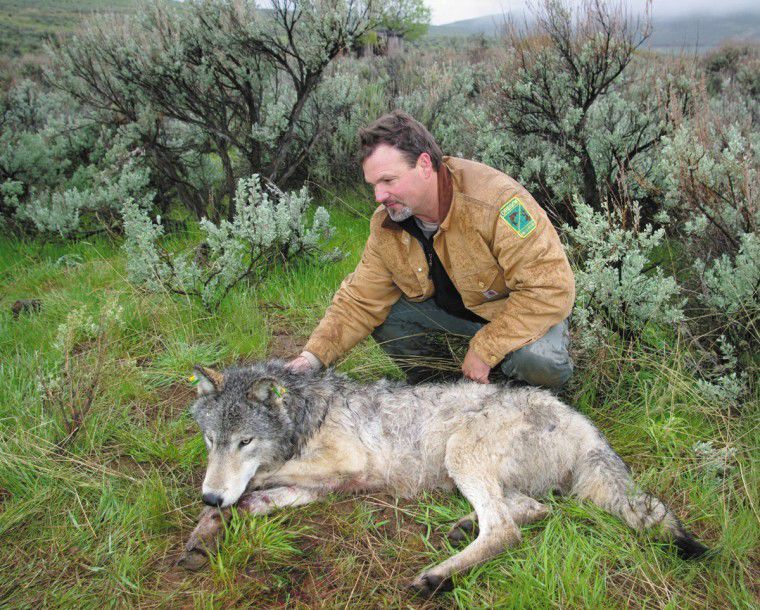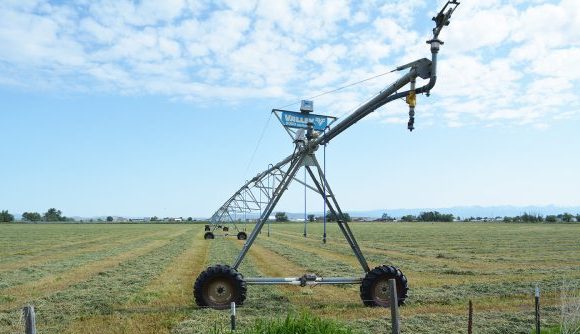Wolves amongst us
Published 4:00 pm Tuesday, December 13, 2011

- <p>In this May 3, 2009 photo provided by Oregon Department of Fish and Wildlife, Russ Morgan, ODFW wolf coordinator, is seen with a wolf as it recovers from anesthesia used during a radio-collaring effort. Conservation groups filed a lawsuit Thursday, July 1, 2010 in U.S. District Court in Portland, Ore., seeking to stop a kill order on two wolves in Northeastern Oregon blamed for killing cattle.</p>
LA?GRANDE – When Russ Morgan gets to his office at the Oregon Department of Fish and Wildlife in La Grande, he is greeted by a slew of emails and phone messages reporting possible wolf sightings or wolf tracks and requests for wolf locations.
Morgan, the department wolf coordinator, then pulls up GPS data showing locations of the Imnaha pack and sends a mass text message to a list of Wallowa County ranchers. The location is already history because the collar on OR-4, the pack’s alpha male, updates every three hours. But it gives ranchers a general location, Morgan said.
“As numbers increase in Oregon, it’s going to be a real challenge to provide the level of information that’s demanded,” he said.
Morgan, 49, as wolf coordinator since 2006 has been point man for the state plan to allow the gray wolf to repopulate Oregon. The job is not one that satisfies many with a stake in the outcome. Wolf advocates complain the state under Morgan’s direction resorts too quickly to killing wolves that prey on livestock. Ranchers complain he doesn’t move fast enough. But Morgan, who started his 25-year career with the state fresh out of Oregon State University, said he read the Oregon Wolf Conservation and Management Plan and saw in it an opportunity even before he applied for the job. The plan is doable, he said; wolves can live in Oregon successfully. Not that living with them will be easy, especially at first.
“It is important that we’re evidence-based and evidence-driven,” he said. “The thing that I think will be the case for many years is every decision we make will have supporters and detractors.”
Wolves moving in
As the district wildlife biologist in Heppner for 16 years, Morgan dealt with another endangered species, the Washington ground squirrel, the habitat for which is also coveted for agriculture. But that job paled in comparison to the notoriety attached to managing a high-profile endangered species like the gray wolf. He started out dividing his time about evenly between his desk and the field, tracking and collaring wolves. But that balance shifted dramatically as wolves made their presence known, particularly in Wallowa County, where the Imnaha pack began preying on livestock.
“I would say wolf management at face value is about 10 percent to do with wolves and about 90 percent to do with the social issues that come from having wolves,” he said.
Morgan and company currently compile a monthly wolf newsletter with updates on reported sightings, livestock losses and investigations, non-lethal measures used and locations of each of the state’s four packs.
In some cases the information he provides is considered helpful, but other times it doesn’t measure up to ranchers’ standards.
“At times it works really good, other times it doesn’t,” said Rod Childers, Oregon Cattleman’s Association wolf task force chairman. “But, we met with them in the summer and the fall to work out some of the issues. We have got to keep talking.”
Some environmental groups describe the amount of information released as “uncomfortable” because it presents an opportunity for poaching.
“It depends on how the information is used,” said Steve Pedery, Oregon Wild conservation director. “If it is used to track and record information on wolves in the state, that’s a good thing. If it needs to be used for depredation prevention that’s a good thing, but if people want to use that information for poaching an endangered species, that’s not good.”
Oregon wildlife managers, ranchers and environmentalists braced for the wolves’ impact years before they arrived. Wolves were first reintroduced to the northern Rocky Mountain region in 1995. Their numbers rapidly increased, resulting in their removal from endangered status and subject to controlled hunts in Idaho and Montana.
Wildlife biologists anticipated wolves expanding their territory into Oregon. The first immigrant wolf from Idaho was detected in 1999, but the first pack – the Wenaha pack – did not establish itself until 2008. The Imnaha pack followed in 2009, Morgan said.
Wolf baggage
“The issue is so polarized,” he said. “Everybody is fighting to get out their message, the message itself is polarized. More than half of what you can see, read, find and dig up, is not based in fact.”
This problem occurs on both sides of the wolf argument and makes wildlife managers’ jobs difficult, Morgan said.
“It just reinforces what our job has to be, to look beyond the polarized sides and evaluate this at a factual level and on a scientific basis,” Morgan said. “The wolves are similar to other species we manage at least from a biological side.”
Socially and politically, however, wolf management is completely different. When the department of fish and wildlife began drafting a wolf management plan, livestock producers were clear about their opposition and environmental groups were strongly in favor of the plan. Now both sides have switched their stances in response to three conservation groups – Oregon Wild, Cascadia Wildlands and Center for Biological Diversity – filing a lawsuit staying the elimination of two Imnaha pack wolves.
The conservation groups challenge the management plan, saying livestock producers have not done their part by exhausting non-lethal methods of warding off wolves. From the biological standpoint, Morgan said non-lethal measures have a limited time of effectiveness, in some cases are not practical and do not work in every setting. Part of his job is providing education and information to the public and producers using non-lethal methods.
“There’s this perception that they work all the time and that’s just not the case,” Morgan said.
But, ranchers say problem wolves need to be eliminated after multiple livestock attacks and the wolf management plan allowed fish and wildlife officials to eliminate chronic offenders. Morgan said he is one who’s had to track and shoot a condemned wolf.
“Lethal action is not a part that any of us like at all, but that’s what we signed up for as wildlife managers,” Morgan said. “It’s all about trying to maintain that balance between people and wildlife.”









